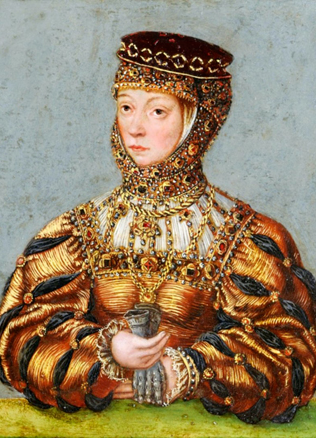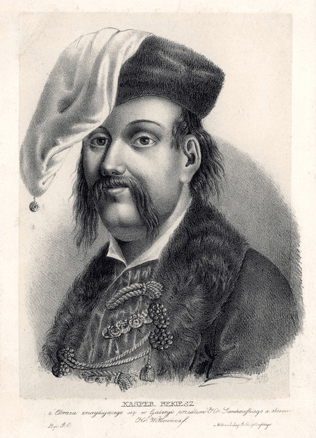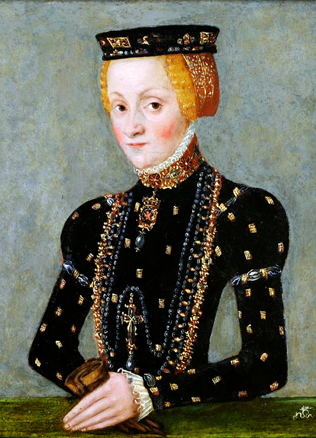A struggle between the Grand Duchy of Lithuania and Moscow for supremacy
After Lithuania adopted Christianity in 1386, it became a part of the Christian world and a partner of equal value to other Christian states; it was recognised by the most important European states. A significant change – Jogaila (Pol. Jagiełło) became King of Poland – contributed greatly to the new status of the Grand Duchy of Lithuania as a Christian state. Concentration of two states that covered large territories and were located between the Eastern and Western states in the hands of one state put the ruling dynasty next to the largest European dynasties of that time. The position of the Kingdom of Poland also determined the status of the Grand Duchy of Lithuania, “the reputation” of the Jagiellonian dynasty on the international arena. At that time the sovereign State of Moscow that was still forming and its monarchs had to win their place among the ruling courts of Europe. In the second half of the 15th century, the neighbouring countries became the first target of that struggle and the Grand Duchy of Lithuania found itself among them. It was sought to establish the sovereign status of the monarch of Moscow with respect to them on the basis of supremacy.
New “accessories” of the title
The issue of the title of the Ruler of Moscow, the attribute representing the rank and power of the monarch, became the most important aspect of the competition for supremacy. Diplomatic quarrels over its new elements formed a large part of interstate communication, and this issue often became the main subject of the negotiations. The first stage of the “titular conflicts” started in 1493 when Grand Duke of Moscow Ivan III used a new component of the title for the first time during the interstate contacts –– the Ruler of entire Russia: “Ivan, by God’s will. The Ruler of entire Russia and Grand Duke of Vladimir, Moscow”. This title had to accentuate the “eternal” rights of Moscow Rulers for entire Russia that was only partly united until that time and at the same time to underline the predatory nature of the power of the Grand Duke of Lithuania with respect to the old land of Kievan Rus’ belonging to the Grand Duchy of Lithuania and to contest the rights of the Jagiellonian dynasty to these territories. The new part of the title demonstrated the increased power of the Grand Duke of Moscow and signified his status.
“
The first stage of the “titular conflicts” started in 1493 when Grand Duke of Moscow Ivan III used a new component of the title for the first time during the interstate contacts –– the Ruler of entire Russia: “Ivan, by God’s will. The Ruler of entire Russia and Grand Duke of Vladimir, Moscow”.
Realising the essence of these aspirations of Moscow, the court of Vilnius expressed discontent about the novelties – in diplomatic correspondence the monarch of Moscow was accused of attributing a too “grand name” to himself. To deflect the criticism about the components of the new title the other party used arguments of historical tradition explaining that Ivan III had inherited the right to title himself like that from his ancestors: “Our Ruler, through an envoy in his letter to your Ruler wrote nothing too grand, he introduced no novelties, what God presented him with; from his grandfathers and great-grandfathers, from the beginning by natural right he is the Ruler of entire Russia.” At that time the declaration of the principle of inheritance was an important stage of Ivan’s III struggle for establishing the sovereign status on the international arena. These quarrels were a prologue to a long diplomatic struggle, which made the interstate relations more difficult. Following practical reasons the Lithuanian party agreed to include the “grand name” of Ivan III in the letters of the Peace Treaty of 1494; however, later it refused these concessions. It was only at the beginning of the 16th century that the Grand Duchy of Lithuania softened its positions starting the negotiations over the recognition of the new title of the monarch of the Muscovites. Lithuania agreed to make concessions when, during the 1500-1503 military conflict with Moscow, it experienced failures that complicated its position considerably. The conflict over the title ended only after 1503 when the Lithuanian party began to use the new elements of the title of the monarch of Moscow regularly in the interstate documents.
Interstate “name calling”
The change in the titles of Moscow monarchs did not end with the above-mentioned changes. New territorial achievements provided the descendants of Ivan III with the opportunity to include ever new elements in them. In the second decade of the 16th century, the title of Grand Duke of Moscow Vasilij III was supplemented with the title of the Grand Ruler. It was used as a part of an official address in the negotiations between the Grand Duchy of Lithuania and Moscow that were renewed in 1517: “The Grand Ruler, by God’s will, the Ruler of entire Russia, the Grand Duke.” At that time these changes did not bring about any new disagreements, the Lithuanian envoys did not protest about the new addition, and later Grand Duke of Lithuania Sigismund the Old started to use this title for himself in the letters intended for Moscow. Relative peace in the struggle for supremacy came to an end in the middle of the third decade after the diplomatic “war of titles” started, which lasted until the spring of 1532. At that time both Rulers openly belittled one another’s titles.
“
Relative peace in the struggle for supremacy came to an end in the middle of the third decade after the diplomatic “war of titles” started, which lasted until the spring of 1532.
It is difficult to say which party was the initiator of the conflict, however, the sources allow us to think that the Office of the Grand Duke of Lithuania started the conflict having “reduced” the title of Vasilij III in the official documents – its separate parts were often “forgotten” to be written in. This can be assessed as a certain expression of discontent, a response to Moscow’s constant territorial claims and the aspiration for supremacy. Moscow, responding to the violations of the title in the instructions, instructed their diplomatic authorised agents to call Sigismund the Old King in official addresses (without a geographical component of Poland) or not to use any other components of the title. Neither of the participants in this conflict followed its positions consistently. Said violations, contrary to those at the turn of the 15th – the 16th centuries, were not regular, no disagreements about the titles were recorded during the important interstate negotiations. Firm determination of the court of Moscow not to make any concession and respond in the same way made the monarch of the Grand Duchy of Lithuania soften his positions and look for the ways of terminating the “war of titles”. Favourable circumstances formed at the beginning of 1532. The desire to normalise the interstate relations encouraged both parties to exchange declarations of benevolence during the peace negotiations, which ended the more than half a century-lasting conflict.
Moscow’s uncurbed ambitions
At the end of the fifth decade of the 16th century, another diplomatic conflict between the Grand Duchy of Lithuania and the State of Moscow arouse, which was provoked by a new component of the title of Moscow’s monarch Ivan IV. By its meaning the title of Tsar was related to the name of Caesar and was considered to be equal to the title of the Emperor of Byzantium Basileus. By taking this title the Duke of Russia equated himself to Basileus who was called Tsar in Russia since olden times.
“
The title of the Tsar did not only have to demonstrate the equivalence of the positions of Moscow’s monarch with the position of the Holy Roman Emperor but also to raise it one rank higher with respect to the European kings.
The title of the Tsar, as an equivalent of the Byzantine Basileus, could be equated to the rank of the emperor. The title of the Tsar did not only have to demonstrate the equivalence of the positions of Moscow’s monarch with the position of the Holy Roman Emperor but also to raise it one rank higher with respect to the European kings. Seeking to establish the new status for Ivan IV, like for his predecessors, it was necessary to start a difficult diplomatic struggle for his recognition against his closest neighbour – the Grand Duchy of Lithuania and the Jagellonian dynasty that ruled it. King of Poland and the Grand Duke of Lithuania Sigismund Augustus could not come to terms with the rise of the Muscovite who was equal to him in rank earlier.
The first clash in the struggle for supremacy took place in 1549, during the time of the negotiations held in Moscow, when the clerk of the Grand Duchy of Lithuania refused to include the new title of the monarch of Moscow in the letter of the armistice agreement. The representative of Lithuania explained this act by a lack of authorisations because earlier such an official title in the interstate documents was not used. The Muscovites based themselves on historic argumentation in the disputes and accentuated Ivan’s IV right to the title of the Tsar on the principle of inheritance: “With God’s will, our Ruler <…> was crowned Tsar in accordance with the old custom, as his ancestor Vladimir Vsevolodich Monomach was Tsar and Grand Duke in the Russian states, and our Ruler took that name from his ancestor”. The agreement was reached when both parties approved of the combinations of the titles of the rulers: the negotiators agreed that the title of the Tsar would be written in the copy of the armistice agreement of the monarch of Moscow but Ivan IV would not have this title in the copy of the agreement concluded in the name of Sigismund Augustus.
Concessions on the issue of the title were only a temporary retreat of the court of Moscow from the aim, which Moscow did not intend to refuse so easily. The envoys of Moscow, when they were sent to the Grand Duchy of Lithuania, were instructed to try to achieve that the other party should start using the complete title of Ivan IV. A threat was issued to reduce the title of the monarch of Poland and Lithuania. Moscow’s threats did not have any effect on Sigismund Augustus’ determination not to recognise the changed status of the monarch of the Muscovites. Later the diplomatic relations between the Grand Duchy of Lithuania and the State of Moscow worsened due to “the war of titles”. The conflict over supremacy made the interstate communication difficult for a long time. In the middle of the 16th century a life-and-death struggle broke out between both countries: for the Grand Duchy of Lithuania its aim was to survive and for the State of Moscow it was the aspiration to dominate.
Marius Sirutavičius



